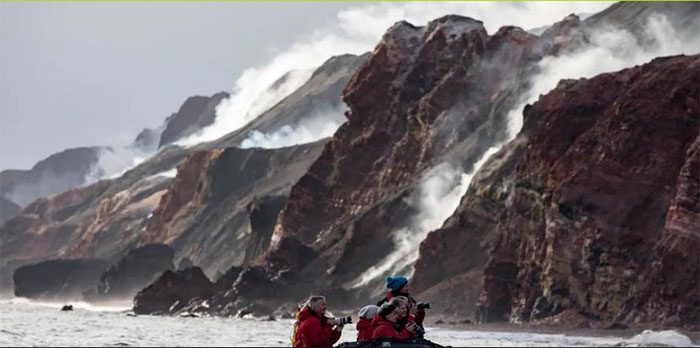The Smoking Hills spontaneously emit smoke, and can kill you instantly if you get too close. This place is also known as hell on Earth.
Located on the eastern side of Cape Bathurst, Northwest Canada, The Smoking Hills are famous for their vivid red rocks and the white smoke that billows from the stones day and night.

People in boats photograph The Smoking Hills – (Photo: FLICKRR).
At first glance, it appears to be the result of volcanic activity or unusual geothermal forces lying deep beneath the Earth’s surface. However, scientists indicate that this smoking hill is the result of a chemical reaction that has been occurring for thousands of years.
This phenomenon occurs when shale oil ignites spontaneously. The shale contains minerals such as sulfur, pyrite (crystalline iron sulfide), and lignite. As the cliffs erode, these minerals are exposed, react with the air, and ignite.
The result of this reaction is an area filled with sulfur dioxide gas, making the air toxic and difficult to breathe.
The area is also dotted with ruby-red, acidic pools rich in sulfur. The high concentration of sulfur means the space is filled with the smell of rotten eggs.
“It really feels like hell on Earth; everything about it is completely horrific,” said Steve Grasby, a research scientist at the Geological Survey of Canada, who studies the geochemistry of sedimentary rocks.
“The ground is very hot. And black. Everything is black. It’s a kind of deep mud. So, you feel like you’re trapped in this hot, humid land. Then there are the smoking chimneys, accompanied by the sound of steam venting. Then you smell the pungent odor of hydrogen sulfide,” Grasby described.
“You have to wear all this protective gear, or you will burn your eyes and throat. It can kill you instantly if you get too close to these spots,” he added.
It is unclear how long the smoke has been rising from the hills, but Grasby stated that the reaction could have begun around 7,000 to 10,000 years ago when glaciers retreated and exposed this rocky surface.


















































